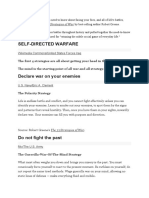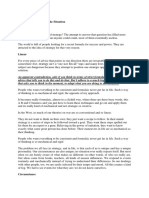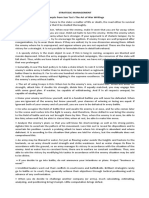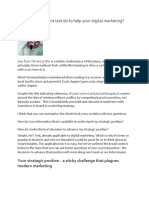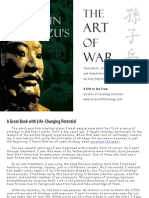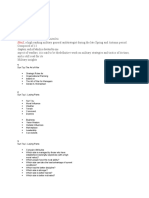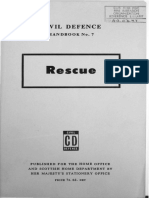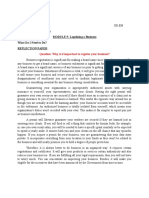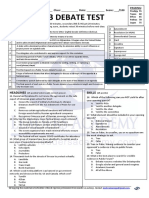📝
BLUEPRINT - War
1. FOCUS
2. PURPOSE
The central theme of The 33 Strategies of War is mastering the art of strategy to navigate lifeʼs conflicts with
precision and foresight.
By distilling lessons from history, military campaigns, and psychological principles, the book equips you to approach
challenges - from personal rivalries to professional battles - as opportunities for growth and success. Greene
emphasizes that strategic thinking is a skill anyone can develop to thrive in competitive and uncertain environments.
BLUEPRINT - War 1
� 3. KEY CONCEPTS
☝ The structure of The 33 Strategies of War by Robert Greene bookmirrors the progression of a strategic
campaign, guiding us through each stage of preparation and execution.
Each phase builds on the one before it, equipping you with the precision and foresight needed to navigate and
win conflicts at any level.
Part I: Self-Directed Warfare
👉 Mastering yourself is the foundation of all external victories. Prepare mentally and emotionally to face
conflict with clarity and discipline.
n° Title Strategies Key Concepts
• Identify True Enemies: Pay attention to actions, not words.
Observe patterns of deceit or hostility, but avoid paranoia.
Declare War on Your
1 The Polarity Strategy •
Enemies
Fight Yourself First: Channel challenges into growth. Stay calm,
define your values, and avoid emotional reactions.
• Avoid Complacency: Past success doesn’t guarantee future
victory. Adapt and innovate.
•
The Guerrilla-War-of-the- Learn, But Don’t Overthink: Recognize failure as a teacher, not a
2 Do Not Fight the Last War
Mind Strategy roadblock. Act decisively in the present.
•
Stay Flexible: Continuously question your strategies and beliefs
to avoid stagnation.
• Control Emotions: Detach from chaos and focus on clarity.
•
Take Action: Ground yourself in achievable tasks to regain focus
Amidst Turmoil, Do Not Lose The Counterbalance
3 during crises.
Presence of Mind Strategy
•
Face Adversity: Train your mind by confronting challenges
head-on.
• Commit Fully: Eliminate safety nets to focus all energy on the
goal.
Create a Sense of Urgency
4 The Death-Ground Strategy
and Desperation
• Leverage High Stakes: Place yourself in environments where
failure isn’t an option.
BLUEPRINT - War 2
� Part II: Organizational (Team) Warfare
👉 The focus shifts to interactions with others and strategies to manage and lead groups. Victory requires a
disciplined, united group aligned with a shared mission.
n° Title Strategies Key Concepts
• Clear Vision: Provide inspiring yet flexible commands.
• Strategic Roles: Assign tasks matching each member’s
Avoid the Snare of The Command-and-Control
5 strengths.
Groupthink Strategy
• Encourage Critique: Balance collaboration with decisive
leadership.
• Decentralize for Speed: Empower smaller groups with
autonomy and clear goals.
The Controlled-Chaos
6 Segment Your Forces •
Strategy
Maintain Cohesion: Align actions through shared philosophy and
regular check-ins.
• Unite with a Purpose: Inspire action through an emotionally
compelling mission.
•
Transform War into a Lead by Example: Earn respect by facing challenges alongside
7 The Morale Strategies
Crusade your team.
•
Eliminate Negativity: Remove chronic disruptors to preserve
morale.
Part III: Defensive Warfare
👉 Defensive warfare is a masterstroke of control. By staying resilient, protecting your position, and waiting for
the perfect moment to strike, you can turn even the strongest
aggressor’s force against them.
n° Title Strategies Key Concepts
• Know Your Limits: Conserve energy for impactful actions.
Avoid the Snare of The Command-and-Control •
8
Groupthink Strategy Strategic Targeting: Strike where it hurts most for maximum
efficiency.
• Counterattack Wisely: Wait for your opponent to expose their
weaknesses before striking.
9 Turn the Tables The Counterattack Strategy
• Stay Silent: Resist reacting impulsively to maintain control over
the conflict.
• Project Unpredictability: Instill fear and doubt in potential
aggressors.
Create a Threatening
10 Deterrence Strategies •
Presence
Build Reputation: Consistently demonstrate strength to deter
challenges.
BLUEPRINT - War 3
� n° Title Strategies Key Concepts
The Nonengagement • Strategic Retreat: Use nonengagement to regain control and
11 Trade Space for Time
Strategy exhaust your opponent.
4. ACTIONABLE STEPS - The Journey to Become a Strategic
Thinker
👉 This section is about taking action. Through these tools and exercises, you'll start applying the strategies in
your daily life, enhancing your decision-making and leadership abilities.
The Enemy Identification Table
💡 The goal of this table is to help you identify both internal and external obstacles (your "enemies") that
influence your mindset and actions, so you can understand their impact and learn to manage or overcome
them.
Instructions:
Step 1: Review the Questions
Carefully go through the following reflective questions to determine whether your obstacles stem from
internal or external sources
Step 2: Identify Your Enemy
From the list of potential enemies provided (internal and external), select the ones that resonate with your
challenge.
Internal Enemies:
Fear of failure
Perfectionism
Self-doubt
Negative self-talk
Procrastination
Lack of discipline
Fear of rejection
Overthinking
Insecurity
Impostor syndrome
External Enemies:
Toxic relationships (friends, family, colleagues)
Overwhelming responsibilities
Distracting environment
Financial stress
Peer pressure
Unsupportive community
BLUEPRINT - War 4
� Cultural or societal expectations
Lack of resources (time, money, tools)
Step 3: Explain Why This is Your Enemy
For each enemy you’ve identified, ask yourself:
Why is this enemy holding me back?
How is it affecting my decisions, emotions, or actions?
Step 4: Reflect and Strategize
Now that you’ve identified your enemy and its effects, consider how you can address it:
What practical steps can you take to manage or overcome it?
What resources, habits, or mindset shifts can help neutralize its influence?
Internal Enemies
Next Step to
_ Questions Answer Enemy Why This is My Enemy
Overcome It
I avoid opportunities
What fears or insecurities hold Start with small risks
Untitled Fear of failure Fear of failure because I don’t want to
me back? and track results.
fail.
What negative thoughts limit "I’m not good It stops me from pursuing Practice daily
Untitled Negative self-talk
my growth? enough.” ambitious goals. affirmations.
Do I procrastinate, and if so,
Untitled
why?
What emotional triggers
Untitled
consistently derail me?
Am I comparing myself to
Untitled others in a way that harms
me?
What beliefs about myself or
Untitled
others are keeping me stuck?
External Enemies
Why This is My Next Step to
_ Questions Answer Enemy
Enemy Overcome It
Constant negativity Limit interactions
Are there people draining Yes, a toxic
Untitled Toxic relationships affects my focus and or set clear
my energy? colleague.
mood. boundaries.
My workspace is Chaos leads to Organize and
Is my environment helping
Untitled chaotic and Distracting environment procrastination and declutter my
or hurting me?
distracting. stress. workspace.
What external distractions
Untitled or responsibilities
overwhelm me?
What societal or cultural
Untitled pressures impact my
decisions?
The Strategic Challenge Table
BLUEPRINT - War 5
� 💡 The goal of this table is to challenge your preconceptions and push you beyond your comfort zone.
Instructions:
Step 1: Reflect on Past Influence
Identify a recent victory or failure that still influences your thoughts and actions today. This could be
something like a past success that boosts your confidence or a failure that has created a mental block.
Step 2: Identify Your Mental Barriers
Recognize any mental habits, fears, or beliefs that stem from your past experience. These could be limiting
beliefs, fears of failure, or misconceptions that hold you back.
Step 3: Set a Challenging Task
Choose a task that goes against your current comfort zone or preconceptions. This could involve doing
something you’re afraid of or something that challenges your beliefs.
Step 4: Explain the Importance of This Challenge
Define why this challenge is crucial for your growth. Explain how overcoming it can help you break free from
limiting mental barriers and move closer to your larger goals.
Step 5:Assess the Stakes (Death-Ground)
Reflect on the worst-case scenario if you don’t take action. What could you lose? Conversely, describe the
positive outcomes if you succeed—this is your motivation to take action.
Step 6: Set a Non-Negotiable Deadline
Create a strict deadline for completing this challenge. The pressure of a deadline can push you to take
action.
Step 7: Actionable Steps
Break down the challenge into clear, actionable steps that you can begin immediately. Each step should
push you further toward accomplishing the challenge and breaking through mental barriers.
Identify Challenge Why This Worst Best
Reflect Your to Push Challenge is Outcome if I Outcome if
_ Deadline Actio
Progress on Past Mental Beyond Crucial for Don’t Take I Succeed
Steps
Influence Barriers Comfort Growth Action (1)
Zone
1.
Resea
speec
topics
Give a 5- Staying Increased
2.
Past Fear of minute stuck in my confidence,
Improving Pract
failure in judgment, speech at comfort improved
Untitled Done communication @December 25, 2024 with a
public lack of work or zone, public
skills friend
speaking confidence to a missing speaking
group opportunities ability
3. Giv
speec
front
small
group
Not
Untitled
started
BLUEPRINT - War 6
� The Leadership in Action Table
💡 Now, with a clearer understanding of yourself and the forces shaping your decisions, it's time to shift focus
outward. The tools ahead will help you master external challenges and seize ppportunities effectively.
Instructions:
Step 1: Establish the Vision
Start by identifying a clear goal for the day or week.
Step 2: Provide Inspiring Commands
Write down instructions that set a direction while allowing for flexibility.
Avoid micromanagement—focus on the what and the why, but leave space for the team to determine the
how.
Step 3: Assign Strategic Roles
Consider your team members’ strengths and assign tasks accordingly.
Ensure each person feels confident and capable in their role.
Step 4: Encourage Critique
Plan a moment to gather input from your team.
Create a safe space where honest feedback is encouraged and appreciated.
Step 5: Enable Autonomous Action
Identify tasks or decisions that can be handled independently.
Empower smaller groups or individuals to act without constant oversight, but provide clear goals.
Step 6: Check for Cohesion
Schedule a brief check-in to align everyone on progress and priorities.
This can be a daily huddle or a weekly meeting depending on the project's needs.
Step 7: Connect Actions to a Greater Purpose
Remind your team why their efforts are important.
Highlight how the goal contributes to a larger mission or vision.
Step 8: Lead by Example
Choose one way to work alongside your team, showing that you’re equally committed.
This builds trust and demonstrates leadership through action.
Step 9: Manage Negativity
Proactively address any challenges or disruptors that may impact team morale.
Approach issues constructively and privately when necessary.
Step 10: Reflect on Results
After completing the leadership cycle, take a moment to review your performance.
Note what worked well and identify areas for improvement in your approach.
BLUEPRINT - War 7
� Vision
Inspiring P
_ Date for the Strategic Encourage Autonomous Cohesion
Progress Command Rem
Day/Week Roles Critique Action Check
What
What
How will What tasks activity How
What is the specific yet
you How will can smaller will you you
overarching flexible
assign you create groups or use to you
goal or instructions
Not tasks to space for individuals ensure by
Untitled mission you will you
started match feedback handle alignment con
want your give to
each team and independently and actio
team to inspire and
member’s discussion? to accelerate maintain a gr
focus on? align the
strengths? progress? shared purp
team?
goals?
"Thi
"Focus on Assign Hold a team 10-min proj
Finalize Let X handle
Untitled @December 2, 2024 Done creativity writing to review huddle to defin
project draft revisions
and quality” X session align com
voic
Not
Untitled @December 3, 2024
started
Not
Untitled @December 4, 2024
started
The Strategic Shield Framework
💡 The goal of this table is to help you identify when you’re under attack, conserve your resources, and respond
strategically by leveraging the principles of defensive warfare.
Instructions:
Step 1: Identify the Threat
Write down any situation or individual that feels like an obstacle or attack. Be specific and objective.
Step 2: Analyze the Threat Type and Urgency
Classify the type of threat (direct, subtle, situational).
Assign a level of urgency to help prioritize your actions.
Step 3: Choose a Strategy
Select the defensive tactic that best aligns with the situation. Use the provided strategies to guide your
response.
Step 4: Plan an Action
Detail the steps you will take to address or mitigate the threat while preserving your resources and control.
Step 5: Reflect on the Outcome
After resolving the situation, revisit the table to evaluate the effectiveness of your strategy and identify
lessons for future scenarios.
BLUEPRINT - War 8
� Potential Type of Urgency Response Planned Outcome
_ Date
Threat Threat Level Strategy Action Reflection)
Observe
Colleague Gained clarity
Subtle behavior and
Untitled @December 2, 2024 undermining Medium Stay Silent without
Undermining document for
me escalating.
evidence.
Delegate low- Finished
Critical Situational Conserve
Untitled @December 2, 2024 High priority tasks to successfully with
deadline Pressure Energy
focus on this. minimal stress.
☝ The final part of this blueprint, covering strategies from Part IV and V, will be available with the release of the
second part of the video—stay tuned! 😉
BLUEPRINT - War 9














